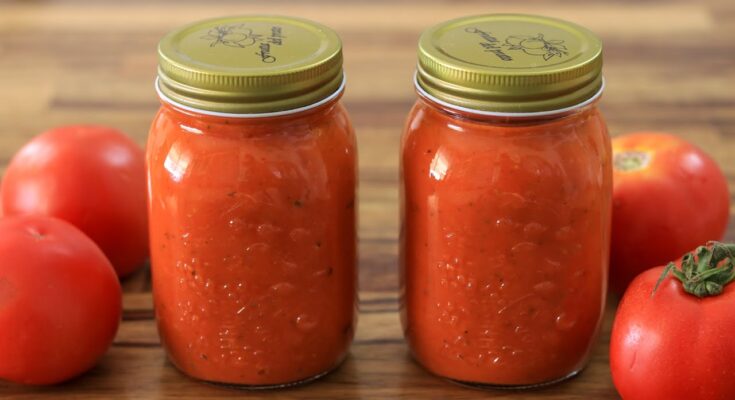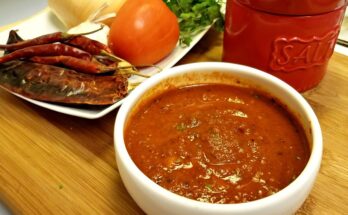Red Sauce Recipe: Red sauce, also known as tomato sauce or marinara, is a rich, vibrant condiment made primarily from tomatoes and often infused with herbs, garlic, onions, and olive oil. It’s the soul of many Italian dishes and is known for its deep flavor, comforting aroma, and velvety texture. Whether you’re layering it in lasagna, tossing it with spaghetti, or dipping mozzarella sticks in it, red sauce is a universal favorite that brings bold flavor to the table.
This sauce isn’t just about taste—it’s about tradition. Passed down through generations, every family seems to have its own variation. Some keep it simple with just tomatoes, garlic, and basil, while others add onions, carrots, or even anchovies for extra depth.
Origins and Culinary Importance
Red sauce finds its roots in Southern Italy, where tomatoes were introduced in the 16th century. Over time, Italians mastered the art of simmering tomatoes into sauces that eventually became foundational to their cuisine. As Italian immigrants traveled the world, they brought their red sauce with them, making it a staple in kitchens across the globe.
Its versatility is unmatched. It can be used as a base for pasta, a dipping sauce, or even as a component in more complex recipes like stuffed peppers or eggplant parmigiana. No matter how you use it, red sauce adds warmth and comfort to any meal.
Ingredients Required
Essential Ingredients
Let’s break down the ingredients that form the base of any good red sauce:
- Tomatoes: Fresh, canned, or even cherry tomatoes work. San Marzano tomatoes are the gold standard for their sweetness and low acidity.
- Olive oil: Adds richness and helps sauté the aromatics.
- Garlic: Infuses the sauce with pungent, irresistible flavor.
- Onion: Optional but recommended for a hint of sweetness and depth.
- Salt and Pepper: To enhance and balance the flavors.
- Fresh Basil or Dried Italian Herbs: These add the classic Mediterranean aroma.
- Sugar (optional): Helps balance the acidity of the tomatoes.
Each of these components plays a role. Tomatoes are the heart, while olive oil, garlic, and herbs are the soul of the sauce.
Optional Add-ins for Flavor Enhancement
You can personalize your red sauce based on your taste preferences or dietary needs:
- Red chili flakes for a spicy kick.
- Bay leaf for a subtle earthy note.
- Parmesan rind added during simmering for an umami boost.
- Grated carrot to sweeten the sauce naturally.
- Butter for a creamier texture and richer mouthfeel.
- Wine (red or white) for depth and complexity.
Feel free to experiment. A great red sauce should be both classic and a reflection of your own cooking style.
Kitchen Tools You’ll Need
Basic Utensils and Equipment
Before you start, make sure you have the right tools:
- Large saucepan or Dutch oven: For even heat and enough space for simmering.
- Wooden spoon: Ideal for stirring without damaging your pot.
- Knife and cutting board: For prepping your ingredients.
- Measuring spoons and cups: To keep your seasoning on point.
These are likely already in your kitchen, and they’re more than enough for a great homemade red sauce.
Optional Tools to Make It Easier
These tools aren’t essential, but they’ll make your life easier:
- Blender or immersion blender: For a smoother texture.
- Strainer or food mill: To remove seeds or skins if using fresh tomatoes.
- Garlic press: If you’re not in the mood to mince.
Having the right gear means you’ll enjoy the process more—and cleanup will be quicker, too.
Step-by-Step Instructions
Step 1 – Prepping the Ingredients
Start by preparing everything so your cooking process goes smoothly. Dice your onion, mince the garlic, and measure out your spices and herbs. If using fresh tomatoes, you’ll want to blanch and peel them first for a smoother texture. For canned tomatoes, just crush them by hand or with a spoon right in the can.
Taking a few extra minutes to prep upfront will make the cooking more efficient and enjoyable. Don’t skip this—it’s the foundation of a well-executed recipe.
Step 2 – Sautéing the Base
Heat olive oil in your pan over medium heat. Add the diced onions first and cook until translucent—about 5 minutes. Next, toss in the garlic and sauté until fragrant, just about 30 seconds. Be careful not to burn the garlic, or it’ll turn bitter.
This base layer is where flavor begins to build. The caramelized sugars from the onion and the aromatic oils from the garlic form the backbone of your sauce’s profile.
Step 3 – Adding Tomatoes and Simmering
Once your garlic and onions are perfectly sautéed, it’s time to add the star of the show—the tomatoes. Whether you’re using fresh peeled ones or canned San Marzano tomatoes, pour them into the pan and stir everything together. Use your spoon to break down any large chunks, especially if the tomatoes were whole.
Bring the mixture to a light boil, then immediately reduce to a simmer. Cover partially and let it cook low and slow for at least 30 to 45 minutes. The longer it simmers, the deeper and more complex the flavors will become. You’ll notice the sauce thicken slightly and take on a rich, dark hue.
During this phase, stir occasionally to prevent sticking and burning. If the sauce thickens too much, a splash of water or broth will loosen it up. This simmering process allows the acids in the tomatoes to mellow, and the flavors from the aromatics to meld beautifully.
Step 4 – Seasoning and Tasting
Now comes the part where you make it your own. Start by seasoning with salt and black pepper. Add your chosen herbs—fresh basil torn by hand or dried oregano, thyme, and a bay leaf. If the sauce is too acidic, a pinch of sugar can help round it out.
Taste, then taste again. A great red sauce should hit all the notes—sweet, savory, slightly tangy, and aromatic. If you’re aiming for more complexity, a splash of red wine or balsamic vinegar will elevate the sauce.
Remember: seasoning is subjective. Add gradually and trust your palate. A little parmesan or butter at this stage can add a luscious, velvety finish that’ll have everyone licking their plates.
Step 5 – Blending (Optional) and Finishing Touches
If you prefer a smooth sauce, this is where the blender comes in. Use an immersion blender directly in the pot, or carefully transfer the sauce to a countertop blender in batches. Blend until you reach your desired texture—some people love it silky smooth, while others like a chunkier, rustic feel.
Once blended, return the sauce to the pan and let it simmer for another 5 to 10 minutes. Finish with a drizzle of high-quality olive oil and a handful of freshly chopped basil for that fresh, herby burst.
Congratulations! You’ve just made a batch of luscious, homemade red sauce that’s perfect for any occasion.
Tips for Perfect Red Sauce
Texture Tips
Getting the right texture is all about patience and method. Want a silky finish? Blend the sauce thoroughly and strain it through a sieve to remove any leftover seeds or skin. Prefer a chunky sauce? Lightly mash the tomatoes and avoid blending.
Also, the amount of time you simmer affects the texture. The longer it cooks, the thicker it gets. You can loosen it with a bit of pasta water if it gets too dense—this starchy water also helps the sauce cling better to pasta later.
Flavor Balance Advice
A perfectly balanced red sauce should be like a symphony: no ingredient should scream louder than the others. If your sauce tastes flat, add a pinch of salt or a splash of acid like lemon juice. If it’s too tangy, a tiny spoon of sugar brings it back in line.
Layering flavors is key. Add herbs in stages—some early for depth and others at the end for brightness. A dash of wine, anchovy paste, or even a spoonful of pesto can infuse your sauce with an unexpected yet delightful twist.
Common Mistakes to Avoid
Overcooking or Undercooking
It might seem impossible to mess up a simple tomato sauce, but timing is everything. Undercooked sauce tastes raw and overly acidic. Overcooked sauce can become overly thick or lose its freshness and color.
Stick to the sweet spot: 30 to 45 minutes of gentle simmering. Stir frequently, keep an eye on the consistency, and don’t rush it. Good red sauce is never made in a hurry.
Overseasoning or Blandness
Overdoing it with salt or herbs can turn your sauce into a bitter or overpowering mess. Underseasoning leaves it tasting flat and lifeless. Always season in stages and taste often. Start small—you can always add more, but you can’t take it out.
And don’t forget the power of fresh herbs and finishing oils. A little fresh basil or a drizzle of extra virgin olive oil just before serving can bring your sauce back to life in an instant.
Variations of Red Sauce
Spicy Arrabbiata Version
If you’re someone who enjoys a bit of fire in your food, then the Arrabbiata version of red sauce will become your new favorite. “Arrabbiata” translates to “angry” in Italian—aptly named for the fiery chili pepper kick that gives the sauce its signature heat.
To make this version, follow the same red sauce recipe but introduce red chili flakes or fresh chopped chili peppers during the garlic sautéing step. You don’t need a lot—just a teaspoon of red pepper flakes can turn up the heat significantly. If you want to intensify the spice, try adding a dash of cayenne or a spoonful of hot sauce toward the end.
The spicy version pairs beautifully with penne pasta, grilled shrimp, or even used as a bold base for a seafood stew. It’s a wonderful twist that keeps the classic flavor intact while giving it a modern edge.
Creamy Tomato Variant
On the other side of the spectrum lies the creamy red sauce, a velvety, rich adaptation often found in dishes like tomato cream pasta or vodka sauce. This version adds a touch of indulgence and smoothness, making it perfect for date nights or cozy dinners.
After your tomato sauce has simmered and the flavors have melded, lower the heat and stir in heavy cream, half-and-half, or coconut cream (for a dairy-free option). Add it gradually, tasting as you go until you reach the desired richness. Some even like to add a splash of vodka—it won’t make it alcoholic, but it enhances the tomatoes’ flavors in a unique way.
Top it off with a sprinkle of parmesan or pecorino romano, and you’ve got a sauce that feels like a warm hug in a bowl.
Best Dishes to Pair With Red Sauce
Pasta Dishes
Let’s face it—red sauce and pasta are a match made in culinary heaven. You can never go wrong with classics like:
- Spaghetti Marinara: Simple and elegant.
- Penne Arrabbiata: Spicy and satisfying.
- Lasagna: Layered with cheese, meat, and red sauce for a hearty dish.
- Stuffed Shells or Manicotti: Red sauce brings these stuffed pastas to life.
Don’t forget gnocchi, ravioli, or even fettuccine. Each pasta shape offers a different texture and sauce-holding capacity, changing the experience every time.
Meat, Seafood, and Vegetarian Options
Red sauce is incredibly versatile beyond pasta. Use it as a base for:
- Meatballs or meatloaf: A spoonful of red sauce adds moisture and flavor.
- Chicken Parmesan: Crispy chicken cutlets topped with sauce and melted cheese.
- Eggplant Parmesan: A perfect vegetarian option.
- Shrimp Fra Diavolo: Spicy red sauce with tender shrimp served over linguine.
You can also use it in stuffed bell peppers, pizza, baked ziti, or even shakshuka. It’s like that one friend who gets along with everyone.
Storage and Shelf Life
Fridge and Freezer Tips
Homemade red sauce keeps incredibly well. In the fridge, store it in an airtight container for up to 5 to 7 days. For longer storage, the freezer is your best friend.
Pour cooled sauce into freezer-safe containers or resealable bags, label with the date, and freeze for up to 3 months. To use, thaw overnight in the fridge or reheat directly on the stovetop over low heat.
Consider freezing in individual portions—perfect for single meals or last-minute dinners.
How Long It Lasts
Here’s a quick guide to help you track freshness:
| Storage Method | Duration |
|---|---|
| Refrigerator | 5–7 days |
| Freezer | Up to 3 months |
Always check for signs of spoilage: sour smell, mold, or discoloration. When in doubt, throw it out.
Nutritional Value of Red Sauce
Calories and Macronutrients
Red sauce is surprisingly healthy when made from scratch. A typical 1/2-cup serving contains:
- Calories: 70–100 (depending on oil and add-ins)
- Fat: 3–5g (mostly from olive oil)
- Carbs: 8–10g (from natural tomato sugars)
- Protein: 1–2g
It’s low in calories, rich in flavor, and full of vitamins and minerals like vitamin C, potassium, and lycopene—a powerful antioxidant linked to heart health.
Health Benefits of Ingredients
- Tomatoes: High in antioxidants, anti-inflammatory properties.
- Olive Oil: Contains healthy fats that support heart function.
- Garlic and Onion: Help fight bacteria and inflammation.
- Basil and Oregano: Natural detoxifiers with immune-boosting properties.
So not only is red sauce delicious—it’s also doing good things for your body.
Red Sauce for Special Diets
Vegan and Gluten-Free Options
Red sauce is one of those wonderful recipes that naturally caters to a wide variety of diets, especially when made from scratch. For vegans, it’s a no-brainer—just use fresh or canned tomatoes, olive oil, garlic, onions, and herbs. There’s absolutely no need for dairy, meat, or animal by-products.
Be cautious with store-bought sauces, though—they sometimes sneak in dairy, cheese flavoring, or even anchovy paste. When you make it at home, you know exactly what’s going in.
For those on a gluten-free diet, red sauce is also inherently safe. But again, check every label. If you’re using packaged seasonings or canned tomatoes, make sure they’re certified gluten-free, as some may include additives that contain gluten.
Want to keep it super clean? Use all organic ingredients, fresh herbs, and a splash of homemade veggie broth. It’ll be just as flavorful, hearty, and comforting—without any dietary compromises.
Low-Sodium Adjustments
Watching your sodium intake? No problem. You can still enjoy red sauce without loading up on salt.
Here’s how:
- Use low-sodium canned tomatoes or opt for fresh ones.
- Skip store-bought broths unless labeled low-sodium.
- Boost flavor with herbs and spices instead of salt—think oregano, thyme, basil, and garlic.
- Add acid like a splash of vinegar or lemon juice to brighten flavors naturally.
Homemade red sauce gives you full control, so you can enjoy all the rich, savory taste with none of the extra sodium your body doesn’t need.
Homemade vs Store-Bought Sauce
Flavor and Nutritional Comparison
Store-bought sauces are convenient, sure—but once you taste homemade red sauce, there’s just no going back. The difference in flavor is night and day. Homemade sauce has depth, complexity, and freshness that bottled sauces simply can’t replicate.
Many commercial sauces are loaded with:
- Excess salt
- Added sugars
- Preservatives
- Artificial flavors
In contrast, homemade sauce is:
- Lower in sugar and sodium
- Free from additives
- Customizable to your taste
- Rich in natural vitamins and antioxidants
It may take a little extra time to make, but the reward is a sauce that’s both tastier and healthier.
Cost and Convenience Factors
Believe it or not, homemade red sauce can be more budget-friendly too—especially if you buy ingredients in bulk or grow your own herbs.
Let’s do a quick breakdown:
| Sauce Type | Cost | Time | Flavor | Health |
|---|---|---|---|---|
| Store-Bought | $3–$8 | 0 min | Moderate | Medium (additives) |
| Homemade | ~$4–$6 | 45 min | Excellent | High (no additives) |
And if you make a big batch and freeze portions, you’ll have your own ready-to-go sauce anytime you need—no preservatives required.
FAQs about Red Sauce Recipe
1. What is red enchilada sauce made of?
Red enchilada sauce is typically made from dried red chilies or chili powder, garlic, onion, tomato paste or sauce, broth (chicken or vegetable), and spices like cumin and oregano.
2. Is red enchilada sauce spicy?
It can be! The spice level depends on the type of chili used. You can adjust the heat by choosing mild, medium, or hot chili powder—or add a dash of cayenne for extra kick.
3. Can I make red sauce ahead of time?
Absolutely! Red sauce can be made in advance and stored in the refrigerator for up to 5 days or frozen for up to 3 months.
4. Is homemade enchilada sauce healthier than store-bought?
Yes. Homemade red sauce lets you control the ingredients—less sodium, no preservatives, and full flavor.
5. What can I use red enchilada sauce for?
Beyond enchiladas, use it on tacos, burritos, nachos, chilaquiles, or even as a base for Mexican-inspired soups and stews.
6. Can I make it gluten-free or vegan?
Yes! Use gluten-free flour or cornstarch as a thickener and vegetable broth to keep it vegan.
7. How do I thicken red sauce?
Simmer it longer to reduce, or whisk in a bit of flour or cornstarch slurry until desired thickness is reached.
Conclusion
Homemade red sauce is more than just a recipe—it’s a kitchen essential, a comforting classic, and a creative canvas for your culinary imagination. From its rich cultural heritage to its modern-day versatility, red sauce has proven it’s here to stay.
Whether you’re a first-time cook or a seasoned foodie, mastering this staple opens the door to endless dishes. From pasta and pizzas to stews and subs, red sauce has you covered. Best of all, it’s simple, budget-friendly, and endlessly adaptable to any dietary preference.
So the next time you crave something hearty, delicious, and homemade, don’t reach for a jar. Instead, reach for a pan and make your own red sauce from scratch—you won’t regret it.



